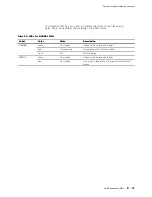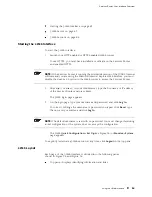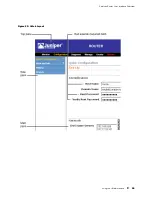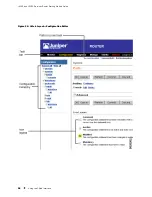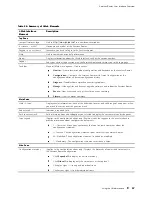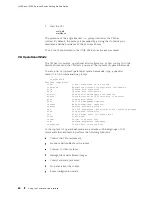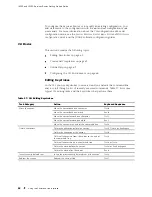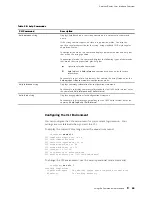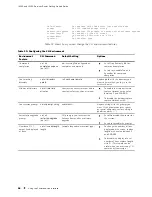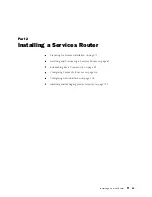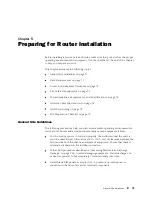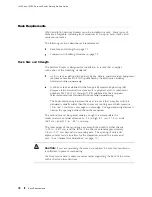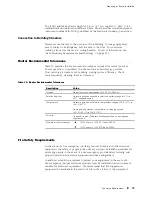
Services Router User Interface Overview
To control the CLI environment, see “Configuring the CLI Environment” on
page 65. To enter configuration mode, see “CLI Configuration Mode” on
page 61. For information about the other CLI operational mode functions,
see the
J-series Services Router Administration Guide
.
CLI Configuration Mode
To configure the Services Router, including system parameters, routing protocols,
interfaces, network management, and user access, you must enter configuration
mode. In configuration mode, the CLI provides commands to configure the
router, load a text (ASCII) file that contains the router configuration, activate
a configuration, and save the configuration to a text file.
You enter configuration mode by entering the
configure
operational mode
command. The CLI prompt changes from
user@host>
to
user@host#
.
To view a list of configuration mode commands, type a question
mark (?) at the command-line prompt. (You do not need to press
Enter after typing the question mark.)
user@host# ?
Possible completions:
Enter
Execute this command
activate
Remove the inactive tag from a statement
annotate
Annotate the statement with a comment
commit
Commit current set of changes
copy
Copy a statement
deactivate
Add the inactive tag to a statement
delete
Delete a data element
edit
Edit a sub-element
exit
Exit from this level
help
Provide help information
insert
Insert a new ordered data element
load
Load configuration from ASCII file
quit
Quit from this level
rename
Rename a statement
rollback
Roll back to previous committed configuration
run
Run an operational-mode command
save
Save configuration to ASCII file
set
Set a parameter
show
Show a parameter
status
Show users currently editing configuration
top
Exit to top level of configuration
up
Exit one level of configuration
wildcard
Wildcard operations
The JUNOS software configuration consists of a hierarchy of
statements
. There are
two types of statements:
container statements
, which contain other statements,
and
leaf statements
, which do not contain other statements. All the container
and leaf statements together form the configuration hierarchy.
Each statement consists of a fixed keyword and, optionally, an identifier that
you define, such as the name of an interface or a username.
Using the Command-Line Interface
61
Summary of Contents for J4350
Page 14: ...J4350 and J6350 Services Router Getting Started Guide xiv Table of Contents...
Page 22: ...2 J series Overview...
Page 68: ...J4350 and J6350 Services Router Getting Started Guide 48 Field Replaceable PIMs...
Page 75: ...Services Router User Interface Overview Figure 25 J Web Layout Using the J Web Interface 55...
Page 88: ...J4350 and J6350 Services Router Getting Started Guide 68 Using the Command Line Interface...
Page 90: ...70 Installing a Services Router...
Page 100: ...J4350 and J6350 Services Router Getting Started Guide 80 Site Preparation Checklist...
Page 112: ...J4350 and J6350 Services Router Getting Started Guide 92 Powering a Services Router On and Off...
Page 144: ...J4350 and J6350 Services Router Getting Started Guide 124 Verifying Secure Web Access...
Page 162: ...142 Maintaining Services Router Hardware...
Page 194: ...J4350 and J6350 Services Router Getting Started Guide 174 Troubleshooting Hardware Components...
Page 204: ...184 J series Requirements and Specifications...
Page 220: ...J4350 and J6350 Services Router Getting Started Guide 200 ISDN RJ 45 Connector Pinout...
Page 267: ...Part 5 Index Index 247...
Page 268: ...248 Index...

